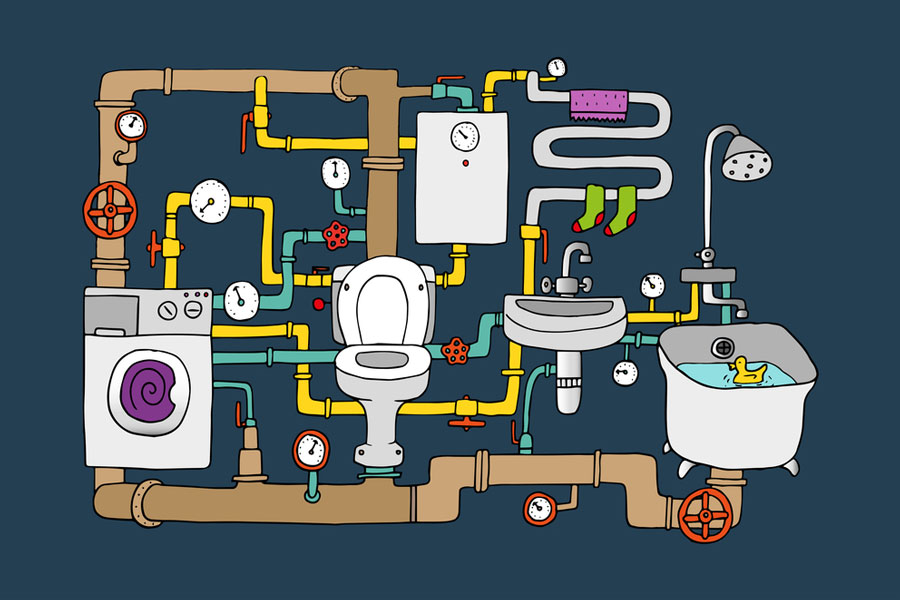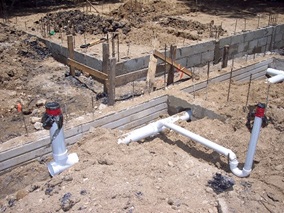Examining Your House's Plumbing System Anatomy
Examining Your House's Plumbing System Anatomy
Blog Article
Just how do you really feel about Understanding Your Home's Plumbing Anatomy?

Comprehending how your home's pipes system works is essential for every house owner. From providing clean water for alcohol consumption, food preparation, and bathing to safely getting rid of wastewater, a well-kept plumbing system is crucial for your family members's health and wellness and comfort. In this thorough overview, we'll explore the elaborate network that makes up your home's pipes and offer ideas on maintenance, upgrades, and handling typical issues.
Intro
Your home's plumbing system is more than simply a network of pipes; it's an intricate system that ensures you have access to tidy water and reliable wastewater removal. Knowing its parts and how they interact can assist you avoid costly repairs and make sure everything runs efficiently.
Fundamental Components of a Pipes System
Pipelines and Tubing
At the heart of your pipes system are the pipes and tubes that carry water throughout your home. These can be made from various materials such as copper, PVC, or PEX, each with its benefits in terms of durability and cost-effectiveness.
Components: Sinks, Toilets, Showers, and so on.
Fixtures like sinks, commodes, showers, and bathtubs are where water is made use of in your home. Comprehending just how these fixtures connect to the pipes system aids in identifying issues and intending upgrades.
Valves and Shut-off Factors
Shutoffs control the circulation of water in your plumbing system. Shut-off valves are critical during emergency situations or when you require to make repair work, permitting you to isolate parts of the system without interfering with water circulation to the whole house.
Water System System
Key Water Line
The main water line links your home to the metropolitan supply of water or a personal well. It's where water enters your home and is dispersed to numerous fixtures.
Water Meter and Pressure Regulatory Authority
The water meter actions your water use, while a pressure regulator makes sure that water moves at a safe pressure throughout your home's pipes system, preventing damage to pipes and components.
Cold Water vs. Warm water Lines
Understanding the distinction between cold water lines, which provide water straight from the major, and hot water lines, which carry warmed water from the water heater, assists in repairing and preparing for upgrades.
Drainage System
Drain Pipeline and Traps
Drain pipes bring wastewater far from sinks, showers, and bathrooms to the sewage system or septic system. Catches protect against sewer gases from entering your home and also trap debris that can trigger obstructions.
Air flow Pipelines
Air flow pipes permit air right into the water drainage system, protecting against suction that could slow drain and trigger catches to empty. Proper ventilation is important for preserving the stability of your plumbing system.
Importance of Proper Drainage
Ensuring correct water drainage protects against back-ups and water damage. Frequently cleaning up drains and maintaining catches can stop expensive repair work and extend the life of your pipes system.
Water Furnace
Sorts Of Hot Water Heater
Hot water heater can be tankless or standard tank-style. Tankless heaters warmth water as needed, while storage tanks store heated water for prompt use.
Updating Your Pipes System
Reasons for Upgrading
Updating to water-efficient components or changing old pipes can improve water top quality, lower water expenses, and enhance the value of your home.
Modern Pipes Technologies and Their Advantages
Check out modern technologies like wise leakage detectors, water-saving bathrooms, and energy-efficient water heaters that can conserve cash and decrease environmental influence.
Price Considerations and ROI
Compute the in advance costs versus long-term financial savings when thinking about pipes upgrades. Lots of upgrades spend for themselves with reduced energy expenses and fewer fixings.
Exactly How Water Heaters Connect to the Pipes System
Comprehending how hot water heater link to both the cold water supply and warm water circulation lines aids in identifying issues like not enough warm water or leaks.
Maintenance Tips for Water Heaters
Consistently flushing your hot water heater to eliminate sediment, examining the temperature setups, and examining for leakages can prolong its life-span and enhance power efficiency.
Usual Plumbing Concerns
Leakages and Their Causes
Leakages can occur as a result of aging pipelines, loose installations, or high water pressure. Attending to leaks immediately prevents water damages and mold and mildew growth.
Blockages and Clogs
Blockages in drains and commodes are frequently triggered by purging non-flushable products or a build-up of grease and hair. Utilizing drainpipe screens and bearing in mind what goes down your drains can avoid obstructions.
Signs of Pipes Troubles to Watch For
Low tide pressure, slow-moving drains, foul odors, or uncommonly high water costs are signs of prospective pipes problems that must be resolved without delay.
Plumbing Maintenance Tips
Routine Inspections and Checks
Schedule yearly plumbing assessments to capture issues early. Search for indicators of leakages, corrosion, or mineral accumulation in taps and showerheads.
Do It Yourself Maintenance Tasks
Easy tasks like cleaning tap aerators, looking for toilet leaks utilizing dye tablets, or protecting subjected pipelines in cool climates can avoid major pipes concerns.
When to Call a Specialist Plumber
Know when a plumbing issue requires expert know-how. Trying intricate repairs without appropriate understanding can cause even more damages and greater fixing expenses.
Tips for Lowering Water Use
Straightforward behaviors like fixing leakages quickly, taking shorter showers, and running full tons of washing and recipes can preserve water and reduced your energy costs.
Eco-Friendly Pipes Options
Take into consideration lasting pipes products like bamboo for floor covering, which is durable and environment-friendly, or recycled glass for kitchen counters.
Emergency situation Readiness
Actions to Take Throughout a Pipes Emergency
Know where your shut-off valves lie and just how to switch off the water system in case of a ruptured pipe or major leak.
Importance of Having Emergency Calls Useful
Keep contact information for local plumbing professionals or emergency situation services readily offered for quick response during a pipes dilemma.
Ecological Effect and Conservation
Water-Saving Fixtures and Appliances
Mounting low-flow faucets, showerheads, and toilets can dramatically minimize water usage without sacrificing performance.
Do It Yourself Emergency Situation Fixes (When Appropriate).
Momentary repairs like using air duct tape to patch a leaking pipeline or putting a pail under a leaking tap can reduce damages until a specialist plumbing technician arrives.
Verdict.
Understanding the makeup of your home's plumbing system equips you to keep it efficiently, conserving time and money on fixings. By following routine maintenance routines and remaining educated regarding modern-day plumbing innovations, you can guarantee your plumbing system operates effectively for years to come.
HOW YOUR PLUMBING SYSTEM WORKS
Which Pipes Do What?
Blue lines = fresh water supply entering the building Red lines = hot water supply entering the building Grey lines = pipes carrying waste away from the building and venting pipes carrying gases away from the building (through the roof) YOUR MAIN PLUMBING SYSTEMS
There are two main plumbing systems that support your home s basic plumbing needs one that brings clean water into your home, and one that sends dirty water away from your home. Connected to the toilet, bath, shower, and other faucets in your home, these two systems keep your water flowing in the right directions.
ACCESSING FRESH WATER
Fresh and clean water is brought into your home through the main water supply line . Filtered through one pipe, this water is pressured to flow into the various fixtures in your home at any given time.
This water can be sourced from a well located on your property, a pond or river (mostly cottages), or, as in most cases, from the city s municipal water treatment centre. However, it is important to note that water that is untreated, such as the water siphoned from ponds or rivers, may not be safe to drink. Personal water supplies always need to be treated for hardness and contaminants before consumed.
MUNICIPAL WATER SUPPLIES
Improve taste and odour Remove sediment Eliminate hardness Reduce chlorine COLD WATER SUPPLY VS. HOT WATER SUPPLY
Cold water flows into your home or building through the service line, which then distributes hot or cold water to your fixtures. This line is most commonly run through a central column that runs floor to floor. Hot water runs in short and straight pipes as the longer the pipeline, the more heat that will be lost in the transfer. Having shorter pipes also allows residents to access hot water more quickly.
WASTE WATER SYSTEM
Your wastewater system is divided into two parts pipes that send wastewater away from your home and venting pipes that send sewer gas away from your home. Sewage water travels through pipes that flush the water and waste towards local sewers that are operated and managed by your city or town. Most sewer systems rely on gravity to move the wastewater to where it needs to go.
The further away from your toilet or sink, the larger wastewater pipes become. This allows for waste to be disposed of from various parts of your home or business at once without pipe blockages. The angle and flow of these pipes are also essential for keeping your waste pipes clear of build up.
https://harrisplumbing.ca/how-your-home-plumbing-system-works/

I recently found that piece about Plumbing Installation 101: All You Need to Know while doing research the search engines. Sharing is caring. Helping others is fun. Thank you so much for taking the time to read it.
Call Today Report this page